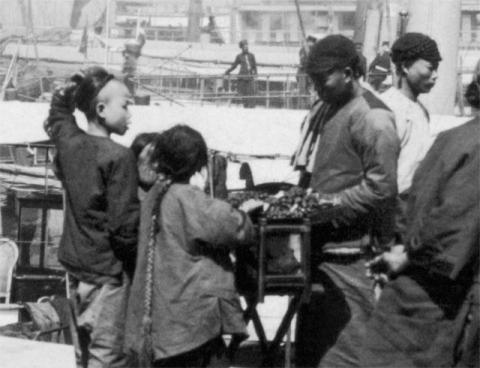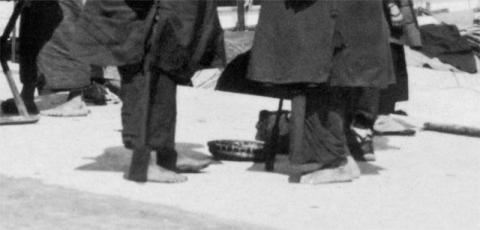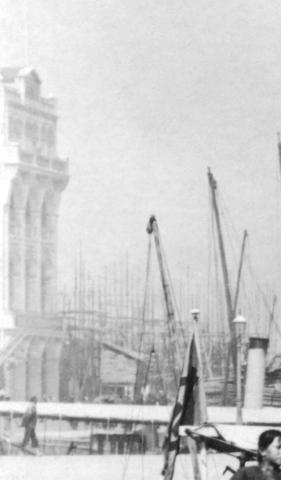The people in this photo come from several very different groups.
On the left is a young, trouserless child in a grubby top, being hurried along by his mum. They look to be heading to the hawker in the centre.
Looking right, there’s a young man who’s obviously from a much wealthier family – he’s the only person among this group wearing shoes. But does money buy happiness? The look on his face says no!
The next group of children have already reached the hawker, who has some kind of snack for sale.
This photo was taken before the 1911 revolution in China, so the shaved forehead and queue (long, braided hair) were still the standard male hairstyle. At first glance the two men above don’t have queues, but look more closely (it’s clearer on the man in the light-coloured shirt), and you can see they are there, just wrapped around their heads.
From the men’s heads, look down to the ladies’ feet.
Not a bound foot in sight, luckily for them. But one item of clothing I find curious is the strap under each foot. The lady on the left looks like she’s wearing stirrup pants, where the strap is part of the trousers. But the lady on the right has worked the strap forward to her toes, showing it was a separate item of clothing that could be worn outside of the trousers. Any idea what the straps were for?
Location
Where have we started our walk through Central? The stereogram’s printed title will help us work it out.
3703 On the Praya, (Water-front) Harbour of Hong Kong, China
COPYRIGHT 1901 BY H. C. WHITE CO.
In 1901, a large reclamation had recently finished here. It expanded Central northwards, so that in 1901 the ‘Water-front’, or ‘Praya’ ran along the new Connaught Road. To find out where along Connaught Road we’re standing, look back at the main photo and note how the road in the foreground heads off to the left.
Then look at the building in the distance, enlarged here.
Its alignment shows that the road swings back to the right again, so there must be a bend in the road, out of sight to the left of the photo. That bend is at the junction of Connaught Road and Pedder Street.
The photographer was east of Pedder Street, so we’re starting our walk close to where the Mandarin Oriental Hotel stands today.
We can see how new the reclamation is by the lack of buildings in the distance – there’s just the one lonely building in the crop above. It won’t stay lonely for long though. Look to its right to see a forest of bamboo poles, showing that its neighbours are already under construction.
Blake Pier
Turn back to the main photo, and if you look at the section between the lonely building and the trouserless child, you should see several hefty stone blocks. These are the start of Blake Pier, which had just opened the previous year.
If the name sounds familiar, you’re probably thinking of Blake Pier in Stanley, which uses part of the roof from this, the original Blake Pier. There’s no sign of the roof in this photo, though, as it wouldn’t be finished until 1909.
Back to 1901, and there is quite an assortment of different people on the pier. On the left is a barefoot man, then in the centre are several men in uniform, both Indian and European. Finally, at the right is a man leaning back in a very nonchalant manner, cane in hand.
It’s not surprising to see this mix of people, as Blake Pier was an important traffic interchange in its day. It’s where you’d board one of the launches that carried passengers to and from the ships in the harbour, or across the water to Kowloon.
To continue the tour of Central, follow Blake Pier to the left and cross over Connaught Road to enter Pedder Street. Walk a short way along the street to reach the location of our next photo.
You've just seen the first photo and its story from the new Gwulo book: Old Hong Kong Photos and The Tales They Tell, Volume 2. This photo begins a sequence that takes you on a walk around old Central.
The new books are currently being finished at the printer, and will be delivered next week. For the next few days, you can still take advantage of several pre-order offers: special price, free shipping, signed copies, and a free sample. Please click here for details.






Comments
1901. On the Praya
Greetings. I seem to remember in early 1950s my grandfather wore pants with straps when he took the ferry to go to work on Connaught Road West. It was cold and windy so the straps kept the pants in shape keeping out the wind. Regarding the woman on the right, the wind appears to be blowing from right to left (strange, east wind on a sunny day?). The wind might have pushed the left pant sideway and to the front. So, it could be strap but there is doubt, the short spot just above ground looks like the ground just beyond it.
This photo was taken in winter time. The hawker could be selling hot food, look like roasted chestnuts kept warm by charcoal in the box.
We could still notice women with bound feet in Hong Kong in the 1960s and my grandmother was one of them. Her feet were forced small and out of shape. She walked at slow speed and much slower on stairs. It was a cruel custom in those days, and I often think of our walk together buying groceries and trips to Guangzhou. Immediately after the 1956 riot, there was a curfew. She and I crossed Tai Po Road at Shek Kip Mei Street slowly, the streets totally deserted except the two of us and a police riot squad carrying shields and guns near us - the scene is unforgettable.
Regards, Peter